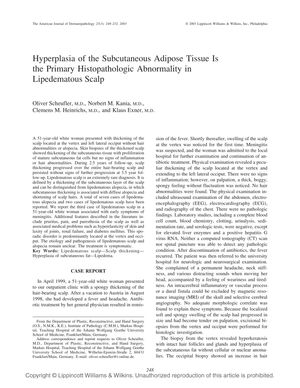Hyperplasia of the Subcutaneous Adipose Tissue Is the Primary Histopathologic Abnormality in Lipedematous Scalp
June 2003
in “
The American Journal of Dermatopathology
”

TLDR Lipedematous scalp is mainly caused by an increase in fat tissue under the skin and is different from lipedematous alopecia.
In 2003, researchers documented the third case of lipedematous scalp in a 51-year-old white woman, a condition marked by an increase in subcutaneous adipose tissue without hair loss or other hair abnormalities. Unlike lipedematous alopecia, which also involves hair growth not exceeding 2 cm, this patient did not exhibit alopecia. Over a 3.5-year follow-up, her symptoms, including early signs of meningitis, did not progress. The study concluded that lipedematous scalp is a distinct pathology from lipedematous alopecia, primarily characterized by adipose tissue hyperplasia without inflammation or hair abnormalities in skin biopsies. With no effective oral or local steroid treatments, management of this benign condition is limited to symptomatic treatment. This case adds to the very few documented instances of lipedematous scalp, with only two prior cases and seven cases of lipedematous alopecia reported before.




